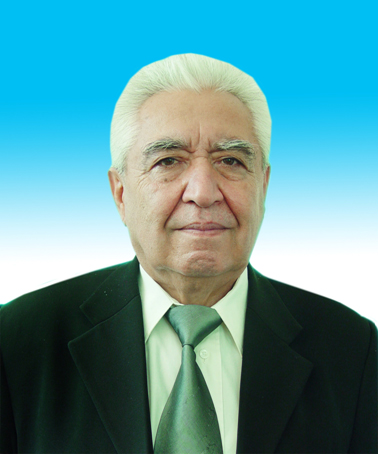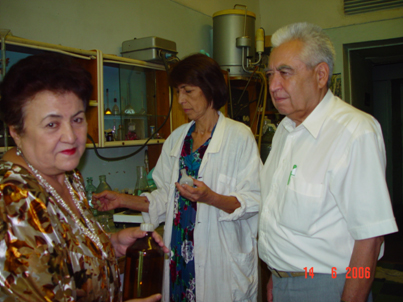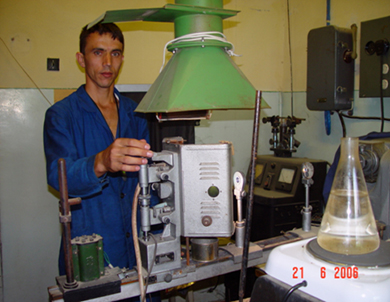 Направления и основные достижения
Направления и основные достижения
LABORATORY OF GEOCHEMISTRY AND ANALYTICAL CHEMISTRY
The first Analytical laboratory in Republic of Tajikistan was organized in Hudzhand in Tajik – Pamirianthe expedition of Academy of Sciences , USSR in 1932. Later the part of equipment of this laboratory was sent to Institute of Chemistry of Tajik department of AS USSR, in which was formed Analytical laboratory ( Heads of laboratory B. N. Dashkevich, G.A. Bekhtle).
In 1962 the laboratory commenced investigations of uranium and close chemical elements in sedimentary rocks of Tajik depression. In 1964 the laboratory was renamed into laboratory of Geochemistry and Analytical Chemistry. From there and on the investigations were coordinated by the Institute of Geochemistry and Analytical Chemistry by V. I. Vernadsky AS of USSR, Moscow (academician A.B. Ronov and prof. S.B. Savvin) and was connected to scientific guidelines “Chemical Composition of Sedimentary Envelope of Earth” and also in field of analytical chemistry.

DALER NABIDZHANOVICH PACHADZHANOV
Head of the Laboratory, academician AS RT, Professor
The results of investigations of laboratory was published in more than 400 articles in different scientific journals and in eight books as well as 14 patents.
The main goal of such investigations is the construction of geochemical model of Tajik depression as a specific structure of sedimentary envelope of Earth- the large intermountain depression .
As a result of investigations of this depression, one in almost forty known within crust of Earth, the details and correct data were obtained for construction of geochemical model. This is fundamental contribution to the goals of geochemistry – investigation of chemical composition of sedimentary envelope of Earth. The dates about content of chemical elements are necessary also for calculation of its balance in different structural zones of Earth crust.
D.N. Pachadzhanov and his colleagues had selected the way of complex studies of sedimentary process.

MAKSUDA NEGMATULLAEVNA ABDUSALYAMOVA
Doctor of sciences, professor, head of projects ISTC T-1597 and Т-1598.
That allowed:
- to create geological basis for interpretation of geochemical data (Lhithology – facial analysis, paleogeographic and paleohydrochemical reconstructions using work out of geochemical indicators of condition of sediments formation, such as boron, strontium , relation of uranium and thorium and others.
- to find out the main ways of distribution a number of chemical elements in sedimentary process (more than fifty, among them such elements as niobium, tantalum, bismuth and another elements, times of distribution of which was absent in literature. Besides it was given detail geochemical characteristics of aridic sedimentary process.
- to predict different types of sedimentary rocks on occurrences in its different metals and also give analysis of possible source of metals in mountains around depression.
The complex investigations have important significance, report and recommendation was forwarded to interested organizations.
- The geochemical background has been established for wide range of chemical elements and metal-bearing capacity of studies ore has been estimated. That was an important step towards establishment and fulfilment of geological exploration.
- Paleographical studies allowed determining the perspective areas of new coal resources.
- The anomaly content of wide range of rare metals have been found within some types of coals and pyroshales. That shows some perspectives for such metals to be used as part of complex mineral resources (silver, gold, uranium, bismuth).
- The new criteria for search of semimetal resources of some metals (gold, bismuth) had been developed.
The industrial concentration of boron, silver, uranium, lithium, and other metals within salts and sediments of Sassikul, Tuzkul, Chukurkul lakes h ave been established.

Laboratory team during their study: D. Pachadzhanov, R. Vakhobova and M. Fatkhulaeva.
Very important extensive research of hydro chemistry of surface water of Tajikistan , which territory is part of important area of stream formation into Central Asia regions. Hydro-chemical study of rivers, dams (Kairakum valley and Nurek – mountainous, from time of load ), as well as number of lakes of Tajikistan are important for various aspects of socio-economical part for republics of Central Asia, estimation of ecology and fresh water resources.

Scientific worker Kh. B. Kabgov.
Establishment and continue of geochemical and hydrochemical study are important for use of modern and development of new complex highly sensitive, reliable and effective analytical methods of natural resources. This also found the wide use in analytical control of enrichment processes, technology of development of new non – organic materials.